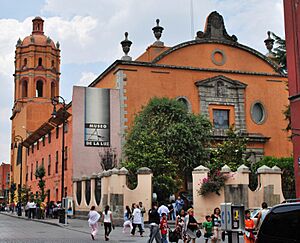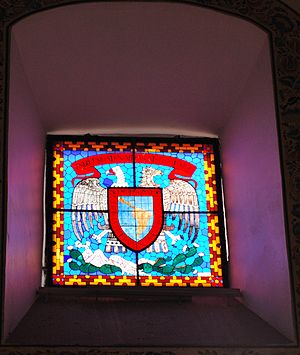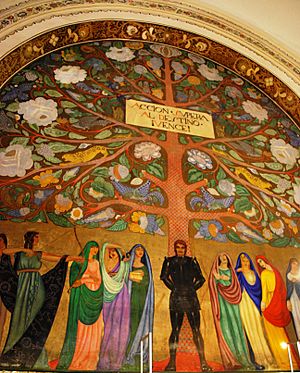San Pedro y San Pablo College, Mexico City facts for kids
The San Pedro y San Pablo College is a historic building in the heart of Mexico City, Mexico. It was once a very important school and church. Today, the church part of the building is home to the Museum of the Constitutions of Mexico. The old school buildings stretch along San Ildefonso Street.
Contents
A Look Back: The College's History
The San Pedro y San Pablo College was the second school started by the Jesuits in colonial Mexico. The Jesuits were a group of missionaries who came to the new Spanish colony in the 1500s. They wanted to build new missions and schools.
Father Pedro Sanchez led the group that founded this college in 1574. It was called the "Great College of Saints Peter and Paul" (Colegio Máximo de San Pedro y San Pablo). It was "Great" because it helped train priests for many cities across the region.
Building the college began in 1576. Rich people like Don Alonso de Villaseca helped pay for it. The church, designed by Jesuit architect Diego Lopez de Arbaizo, was finished in 1603. The rest of the college was completed by 1645.
The college offered higher education to young men, often from European families living in the colony. It had two main parts:
- The Lesser Schools taught subjects like humanities and languages (Greek and Latin).
- The Superior Schools focused on religion, arts, and philosophy.
The school trained young men for both religious and non-religious jobs. It was very popular in the early 1700s, with about 800 students. Famous students included Francisco Javier Alegre and Francisco Javier Clavijero.
In 1767, the Jesuits were forced to leave colonial Mexico, and the college closed. The school building became a barracks for soldiers, then a charity foundation. The church was given to another religious group, the Augustinians. They removed most of its decorations, sending paintings and altarpieces to other churches, like the main cathedral in Mexico City. During this time, the building started to fall apart.
Important Events in the 1800s
When the Jesuits were allowed to return in 1816, they found the college almost in ruins. They worked hard to rebuild it, but the school never fully reopened. This was mainly because of the Mexican War of Independence happening at the time.
After Mexico declared independence in 1821, some very important events took place in the church building:
- In 1823, Agustín de Iturbide, who had been Mexico's emperor for a short time, held meetings here. These meetings led to new rules for the empire.
- In 1824, the first meetings of the Constituent Congress happened here. This group wrote Mexico's first Federal Constitution.
- After Iturbide's rule ended, Guadalupe Victoria was sworn in as Mexico's first president in this very building.
The church was used for worship again from 1832 to 1850. After that, it became a library. Over the years, it had many different uses: a dance hall, an army storage place, a school, a mental hospital, and a customs storage facility.
Changes in the 1900s
From 1921 to 1927, the building was renovated by José Vasconcelos. It became a "Hall of Discussion" and an office for a campaign against illiteracy. Vasconcelos had the church redecorated with beautiful new murals by artists like Xavier Guerrero and Roberto Montenegro.
Later, from 1927 to 1930, the building housed workshops for the Academy of San Carlos, which was part of the National University (UNAM). It also had a popular evening music school. The building became part of the university, and it still is today. In the 1930s, it was used as a preparatory school, a secondary school, a theater school, and an exhibition hall.
In 1944, the church part became the National Periodical Archive, where old newspapers and magazines were kept. It stayed that way until 1979. In 1996, the Museum of Light opened a gallery in the building.
The Building's Design
The Church Section
The front of the church mixes Spanish Baroque and Neoclassical styles. It has a main entrance with two pairs of columns. These columns go up to frame a window with a stained-glass design of the UNAM university's coat-of-arms. Above the window is a triangular top part with a statue of Athena. The very top has a curved pediment with Spain's coat-of-arms. The church's bell tower is on the northwest side, behind the main front.
Inside, the church is shaped like a cross. Thick supports inside create spaces for different chapels. These supports go up to hold a special vaulted ceiling. The inside arches are painted with rustic-style plants and animals by artists like Roberto Montenegro, Jorge Enciso, Gabriel Fernández Ledesma, and Rafael Reyes Espindola.
The church also has three beautiful stained glass windows. Two of them, "The Parakeet Seller" and "The Jarabe Dance of Guadalajara," were designed by Roberto Montenegro. The third window, with the university seal, was designed by Jorge Enciso. Eduardo Villaseñor crafted all these windows.
The School Section
The school buildings themselves are quite plain, except for one facade that has the seal of the Royal and Pontifical University of Mexico. This part of the complex originally had four courtyards, but two were removed to make way for Republica de Venezuela Street. In one of the remaining courtyards, there is a tall monument called an obelisk. It lists the three learning institutions that have been in this spot. Today, this part of the building is used for many things, including Secondary School #6.
Artistic Decorations
The original decorations from the Spanish colonial period are no longer there. Instead, you can see murals and painted walls from the 1920s. These were part of a big project by the Mexican government to add art to public buildings. José Vasconcelos ordered these works. The rustic-style paintings of plants and animals on the arches, several wall murals, and Montenegro's stained glass windows are still preserved from that time.
Murals Inside the Church
In the front part of the church, Roberto Montenegro painted a mural called The Tree of Life, also known as the Tree of Science. This was the first modern mural painted in Mexico. It was restored in 2010 for the new Museum of the Constitutions.
Xavier Guerrero decorated the church's dome in the 1920s with paintings inspired by the zodiac signs.
Murals in the Cloister
The walls of the cloister (a covered walkway) once had paintings by Dr. Atl and Robert Montenegro, but these works are now lost. One important mural was The Festival of the Cross, painted in a stairwell. In another stairway, Roberto Montenegro painted a fresco in 1923, also called The Festival of the Holy Cross. It is said to look similar to the style of another famous muralist, Diego Rivera. Later in the 1920s, Gabriel Fernández Ledesma started a mural about the Mexican Revolution called The Iconographic Museum of the Revolution, but it was never finished.
Museums in the Building
The Museum of Light
The Museum of Light is part of UNAM, Mexico's National Autonomous University. It had exhibition space in San Pedro y San Pablo College from 1996 to 2010. This science museum teaches about light and also shows modern art that uses light.
In 2010, the San Pedro y San Pablo College building closed to become the Museum of the Constitutions. The Museum of Light then moved to the historic San Ildefonso College building, also in Mexico City's center.
The Museum of the Constitutions of Mexico
The Museum of the Constitutions of Mexico (Museo de las Constituciones) is also part of UNAM. It opened in 2011 in the former church area of San Pedro y San Pablo. This museum helps visitors learn about Mexico's history through its different constitutions.
More to Explore
- List of Jesuit sites
- Museums in Mexico City
- Spanish Colonial architecture in Mexico
See also
 In Spanish: Templo y Colegio Máximo de San Pedro y San Pablo para niños
In Spanish: Templo y Colegio Máximo de San Pedro y San Pablo para niños





